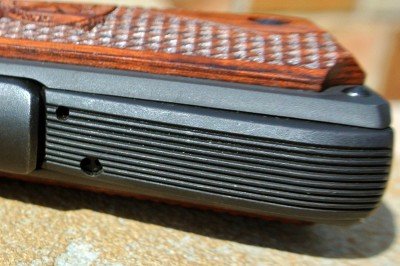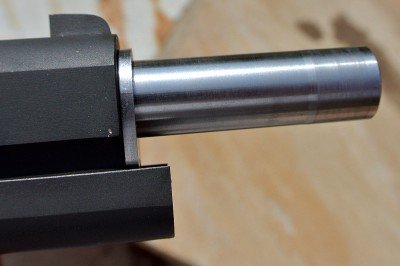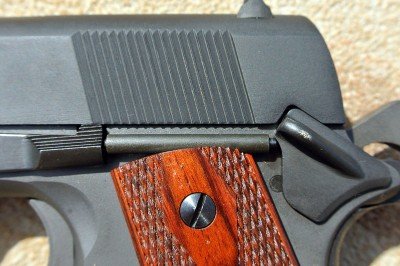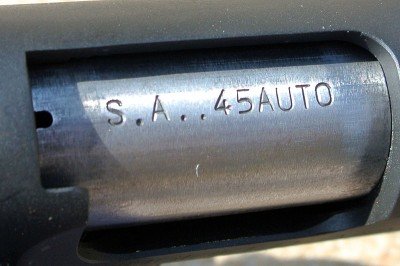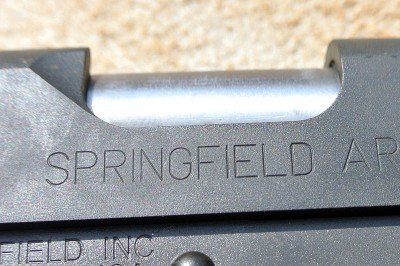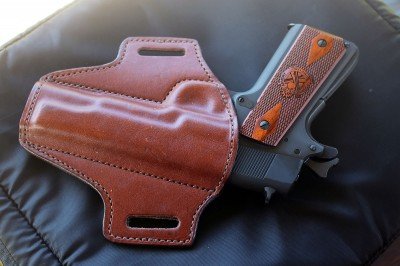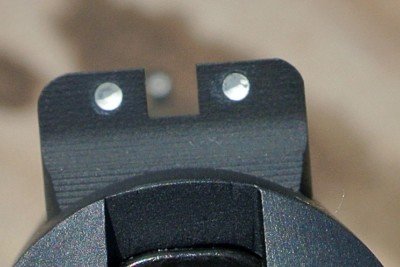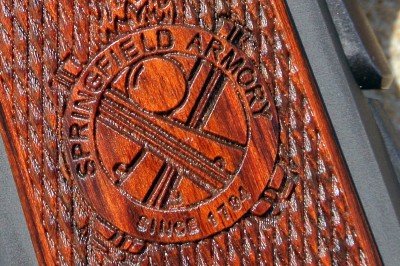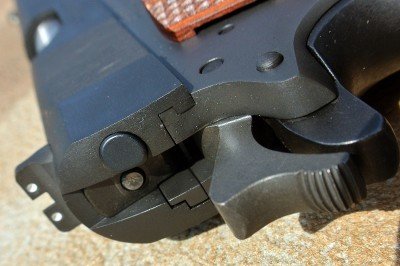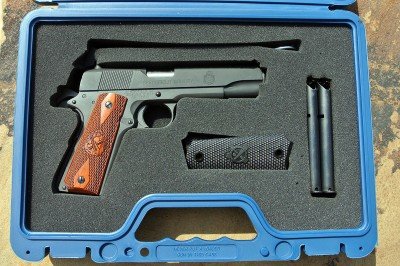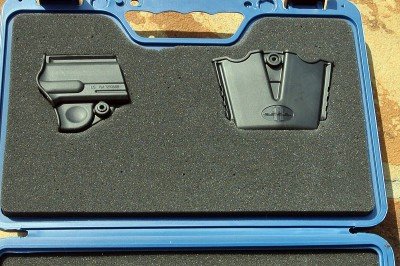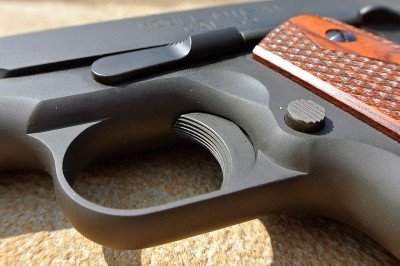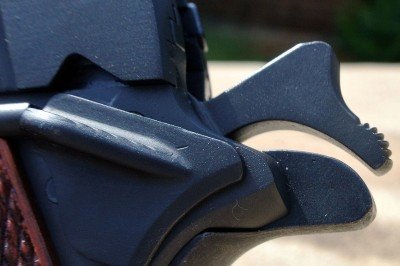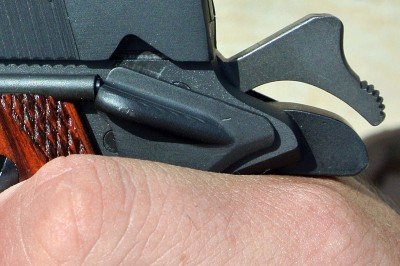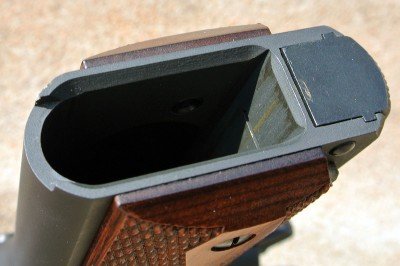[one_half padding=”0 0 0 0px”]
Springfield Duel Contest
[/one_half]
[one_half_last padding=”0 0 0 0px”]
[/one_half_last]
Monday is Gun-Day at Springfield Armory, and they’re giving away guns and gear. This week it is the 1911 A1 Mil-Spec. Contestants can submit entries once an hour, every hour. If you don’t plan on sleeping, that gives you 24 chances a day, every day, until the drawing. In celebration of the Gun-Day giveaway, we’re bringing you a review, so you’ll know what you’re in for if you win.
Looking for a hard working 1911 that is evocative of America’s martial past? Want an affordable .45 ACP that can handle getting knocked around in the toolbox and still put a round on the bull’s eye? Want a gun that looks as good as it shoots? Check out the Mil-Spec, Springfield’s take on the venerable 1911-A1.
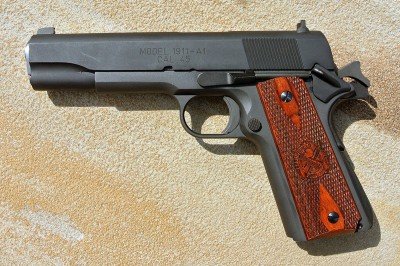
The Mil-Spec 1911. Other than the roll marks it looks exactly like an issued 1911. Until you look a little closer.
Specs
Caliber .45ACP
Recoil System GI Style
Trigger Short, GI/Mil-Spec Style 5 – 7 lbs.
Sights Combat, 3 – Dot
Weight (with Empty Magazine) 39 ozs.
Height 5.5″
Slide Forged Stainless Steel, Matte Rounds with Polished Flats
Barrel 5″ Stainless Steel Match Grade
Length 8.6″
Grip Type Cross Cannon™ Double Diamond Cocobolo & Black Composite (included)
Frame Forged Stainless Steel,
Magazines 2 – 7 Round, Stainless Steel
Springfield Armory has been making 1911s for almost 4 decades. They have offered a plethora of different configurations of the old John Browning design. Some look like straight-up copies of the old military arms. Some of them are tricked out custom shop pistols ready for duty or competition. The Mil-Spec is a solid mix of both styles.
It is not an exact reproduction of an antiquated pistol, though it looks the part. The Mil-Spec is more of an homage to America’s martial past. Yet this capable pistol does more than just pay tribute to the old A1; the Mil-Spec incorporates just enough of the modern features to make this a gun worth carrying.
The Old A1
The Springfield Mil-Spec is a 1911-A1. It says so on the slide. I’m referring to the update that was made to the original 1911 back in 1924. The most important or obvious changes that were made are the arched mainspring housing and the cut outs behind the trigger on the frame.
These two changes were meant to make the pistol fit the curvature of the hand. The Springfield has both of these. The cutouts on the frame are found on almost all of the 1911s that have been produced since the 1920s, but you don’t commonly see the arched mainspring housing on anything other than an old military issue 1911. Even Springfield’s other 1911s don’t have the arched mainspring. That might be its biggest homage to the original military issued pistols, and is certainly the detail most noticeable from afar.
Modern
There are some features that are not truly mil spec on this Mil-Spec. It has been updated and these are good updates that help to make this pistol more functional. For one, the Mil-Spec has a lower ejection port than the originals. A bigger port means more room for a spent case to eject. This should reduce failures like stovepipes. It also changes the angle the casing flies out. The lowered port should keep the spent brass from whacking you in the face, a problem all too common from the early 1911s.
The Springfield Mil-Spec also sports a stainless steel barrel and barrel bushing. The stainless barrel does have a small cutout to check if a round is chambered. The rest of the gun is parkerized. The grips are reminiscent of the military style double diamonds but sport the crossed-cannons-flaming-bomb-ordnance-department styled logo of Springfield Armory. The company Springfield Armory that is, not the defunct US Arsenal.
The slide serrations are also different. These are at an angle instead of the straight ones found on the originals. The angle does make for a better grip when working the slide. They also feel a bit deeper as well.
The most important update has got to be the sights. The original sights on military issued 1911s are tiny by today’s standards. Sure they work, but they are hard to see in low light and even harder to pick up for fast shots in any kind of light. The Mil-Spec has a lot bigger sights. Not the biggest you will see on a 1911, but plenty big and easy to pick up. They also have white dots. These aren’t night sights, but the dots are bright in contrast to the dark parkarized finish allowing them to stand out. These are standard 1911 dovetail sights so it would be easy to replace them if you were inclined to do so.
There is another modern aspect of the Mil-Spec that is an option. They make a full stainless steel model. No gray Parkerizing to be seen on that one. The stainless version is sharp, but hardly mil-spec. It is an odd combination, but still a handsome gun in its own right.
This is a full sized 1911 and fits well within the standard specs. It weighs 39 oz empty, is 5.5 inches tall and 8.6 long. It sports a 5 inch barrel. It also has the standard grip and thumb safeties. Springfield ships these with two 7 round magazines, a small holster and a magazine holster as well. It also comes with a set of black composite grips if you are inclined to change up the look.
The Mil-Spec does have the Springfield Integral Lock System on the mainspring housing and comes with two keys. This lock is a good option for long-term storage. If you aren’t going to use the pistol, and you want to throw a wrench in the system for anyone else using it without your consent, this lock will work.
Other Springfields
Springfield used to make a 1911 they called the GI model. It was a more historic example of a military issued 1911 A1. It had the little sights and lacked the other more modern features. They have since discontinued the GI model. That makes the Mil-Spec the most historically minded 1911 that Springfield is currently making.
The other models they make are far more modern than the Mil-Spec. For one, none of them have the arched mainspring housing. The Range Officer model still has its roots in the old military pistols but it has fully adjustable target sights and a beaver tail on the grip safety to name the two most obvious differences. What it really all boils down to is what you want or expect from a 1911. No matter what that is there should be a Springfield that will fit the bill.
Mil-Spec?
The term mil-spec means made to military specifications. The idea behind something being made to mil-spec is that it is like all of the others, down to the smallest detail. This was all a part of equipment being made by a multitude of different companies and their individual parts all meeting the same specifications. There are strict guidelines and tight mechanical tolerances that applied to the manufacture of the 1911 A1 that were sold to the US Government.
In that regard, the Springfield 1911 A1 Mil-Spec is not mil-spec. But that is its name. It is a very well made and functioning pistol for sure, but the modern updates take it out of spec. But what is a name? It is really the character and functionality that counts. The Mil-Spec is mil-spec in spirit, and functional in the hand.
Fit and Finish
The fit and finish on the Mil-Spec is what you would expect from a mil-spec pistol. That is to say the Mil-Spec is not going to sport a mirror finish. There are a few tool marks visible on the outside and more on the inside. The parkarized finish is well applied. It has lines instead of fine checkering on the mainspring, trigger and thumb safety. All of this fits within what this pistol is. Even with the modern updates, this is very much like an old issue pistol—it looks and feels like one too.
One thing that gets a lot of attention on a 1911 is the slide to frame fit. This Springfield fits together very nicely. There are some tool marks on the rails, but there is not rattle or any unwanted movement of the slide.
Shooting
The Springfield Mil-Spec made a number of trips to the range while I was reviewing it. I shot a wide range of ammo through it. From Winchester white box to Hornady Critical Duty, it fired them all. I was curious how well it would do with hollow point carry rounds. The original design of these guns, which this one follows closely, was built to shoot ball ammo. The shape of the ball ammo served as its own feed ramp. Sometimes the flat nose of a hollow point can get hung up on the feed ramp or the edge of the barrel. This Springfield had no issues whatsoever.
The Mil-Spec feels like it should when firing. This is a full sized 1911. It has some recoil and rise but it’s very manageable if you have put in the trigger time. The white dots on the sights made for fast reacquisition of the target. They also made finding the front sight fast and easy when drawing and firing. I said it above and I will say it again: the white dots are a great yet simple modern touch to this historically inspired pistol. This gun is simply faster than an old hump-and-bump 1911.
Accuracy
Most of the paper punching we did with the Mil-Spec was from 7 and 25 yards. The groups were not super tight, but then again this is not a target pistol. The 7 yard groups were all around 2 inches while the 25 yard ones opened up close to 4 inches. We got about the same results with all of the ammo fired.
We also had some fun with moving targets. I am a big fan of getting away from paper when I can. We had a couple of round targets that could be rolled and shot. This Springfield did well hitting the 6 inch targets as they jumped and jerked across the ground.
Part of accuracy is a good trigger. The Mil-Spec’s trigger breaks just under 6 pounds. That is a bit higher than I’d like for a 1911, but decent. The trigger on this gun has just a touch of grit. If you pull quickly, you won’t feel it. If you set up a shot, you may feel the hitch in the instant before it breaks. It is sufficient, as is, and something that could be cleaned up easily.
Overall
I like this 1911. For one I am a fan boy of the platform and I like my 1911s in all different shapes and sizes. This is a well made and good shooting example that is not overly expensive. That is one of the great things about 1911s. There are a bunch of different guns on the market at a wide range of price ranges. The Springfield Mil-Spec is not the fanciest or shiniest 1911 on the market. It is also not priced like one either. The MSRP on the Mil-Spec is around $700 but the street price is closer to $600. That puts it at the very bottom for American made 1911s. While there are some out there that are less expensive, they are also coming in from overseas. There’s something very American about our philosophy of mil-spec, and the Mil-Spec is, above all, a nod to a very American pistol. For that, Springfield Armory deserves a special kind of credit. Here’s an affordable American made homage to American history, one that can be both a nostalgic icon and a solid carry gun. Hard to beat that combination.
[one_half]
[/one_half]
[one_half_last]
[/one_half_last]
[one_half]
[/one_half]
[one_half_last]
[/one_half_last]
[one_half]
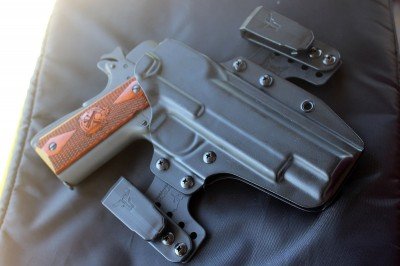
If you want more high-tech holster options, there are plenty. This is a Blade Tech that can be work inside or outside the waistband.
[/one_half]
[one_half_last]
[/one_half_last]
[one_half]
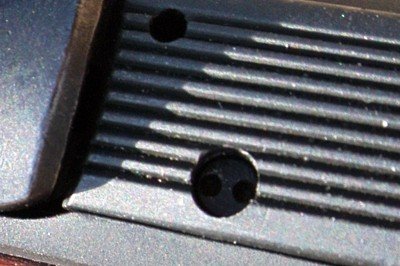
The back of the mainspring housing. Notice the larger hole, which is where the key goes for the integral lock.
[/one_half]
[one_half_last]
[/one_half_last]
[one_half]
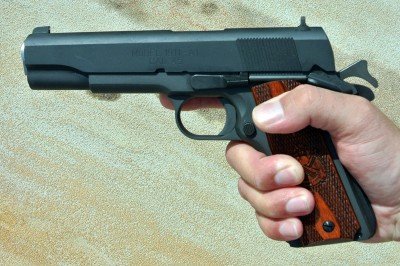
Though the 1911-A1 looks more like an antique than most contemporary 1911s, it is a serious pistol, and ideal for daily carry.
[/one_half]
[one_half_last]
[/one_half_last]
[one_half]
[/one_half]
[one_half_last]
[/one_half_last]
